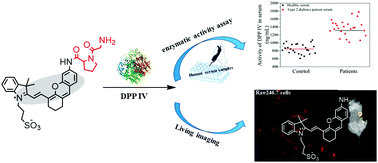Fabrication of a water-soluble near-infrared fluorescent probe for selective detection and imaging of dipeptidyl peptidase IV in biological systems†
Abstract
Dipeptidyl peptidase IV (DPP-IV) is a transmembrane glycoprotein known to regulate T cell activation, which is related to various pathological processes and has become a potential target to treat type 2 diabetes mellitus. Therefore, it is significant for the evaluation of endogenous DPP-IV activity in various biological systems. Herein, a water-soluble near-infrared (NIR) fluorescent probe HCA-D based on cyanine dyes as the fluorophore and glycyl-prolyl peptide as the specific recognition sequence was developed for the assay of dipeptidyl peptidase IV (DPP-IV) activity. Upon addition of DPP-IV, HCA-D can emit a significant turn-on NIR fluorescence signal under physiological conditions and exhibit high selectivity toward DPP-IV. This feature was available for quantifying DPP-IV in the range from 0.62 to 10 ng mL−1 with a detection limit of 0.19 ng mL−1. Furthermore, the present probe was successfully employed for monitoring DPP-IV in serum samples from diabetic and healthy people, and imaging of DPP-IV in living cells and tumor mice models. These results demonstrate that the designed probe provides a promising tool to explore the relationship between DPP-IV and diabetes mellitus or other diseases. Perhaps, it may become a prospective image-guided tumor resection indicator based on the abnormal expression of DPP-IV activity in the future.



 Please wait while we load your content...
Please wait while we load your content...